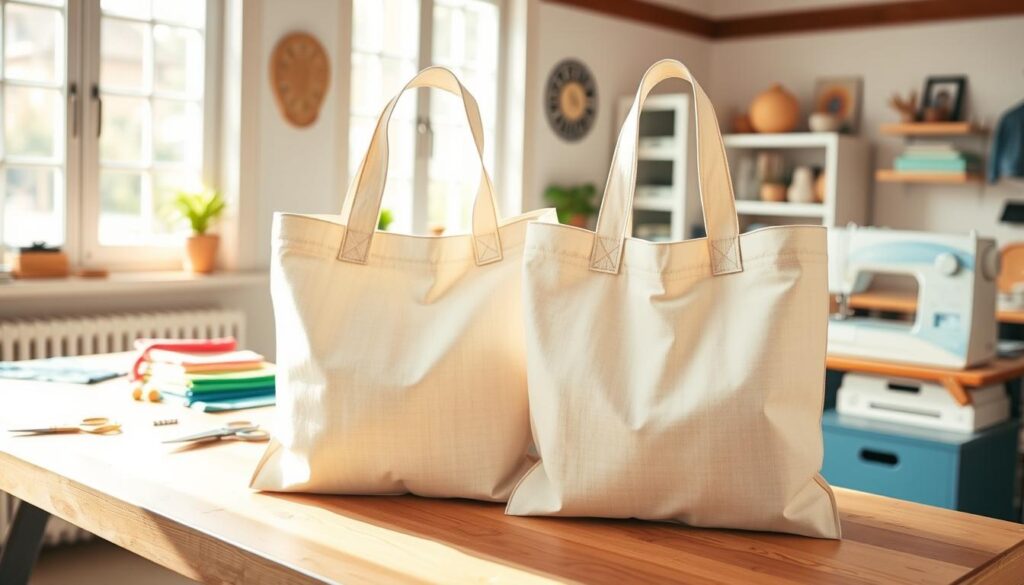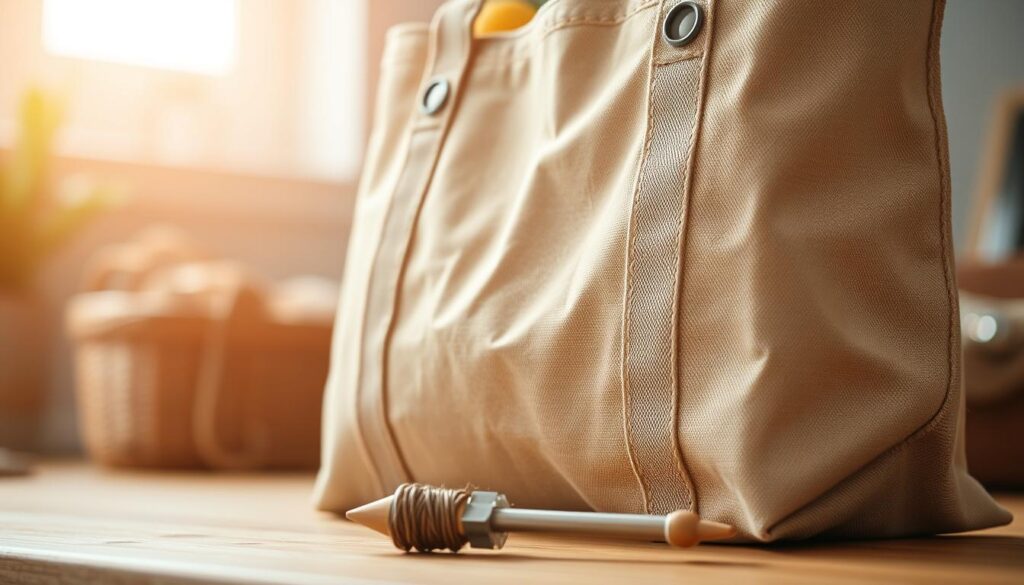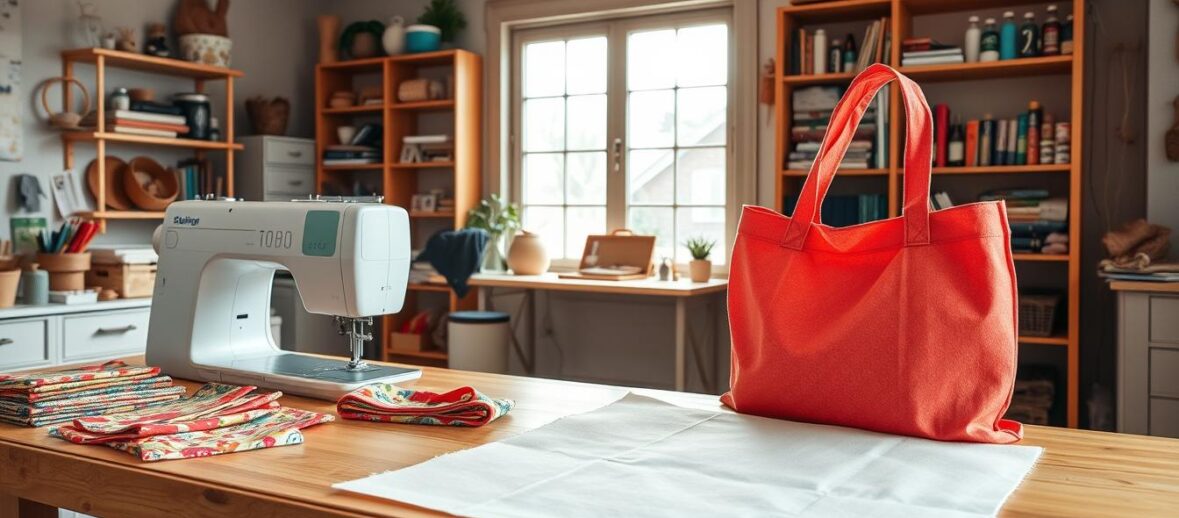Every time I unpacked my groceries, I felt guilty about the disposable plastic bags. That’s when I found easy sew reusable grocery bags. They changed my shopping routine and helped the environment.
Imagine making your own stylish, eco-friendly bags. These DIY grocery bags are easy to make, even if you’re new to sewing.
These bags are good for the planet and practical too. You’ll save money, cut down on plastic waste, and learn a new skill. This skill helps you make eco-friendly choices every day.
Key Takeaways
- Reduce plastic waste with homemade reusable bags
- Learn a new sewing skill perfect for beginners
- Create personalized shopping bags at low cost
- Contribute to environmental sustainability
- Enjoy durable, custom-designed grocery carriers
Essential Materials and Tools for Making Reusable Bags
Making eco-friendly cloth bags is a fun DIY project. It needs the right supplies and preparation. Whether for grocery shopping or personal use, the right materials make it a success.
Before starting, gather the necessary items. The right tools can turn a tough project into a rewarding one.
Fabric Selection Tips
Choosing the right fabric is key for durable bags. Look for materials that can handle repeated use and washing:
- Home décor weight cotton
- Canvas
- Linen blends
- Heavyweight cotton twill
Go for fabrics with tight weaves to prevent stretching and tearing. Natural fibers are best for eco-friendly cloth bags.
Required Sewing Tools
Here are the essential tools for making reusable bags:
- Sewing machine
- Sharp fabric scissors
- Rotary cutter and cutting mat
- Measuring tape
- Straight pins or fabric clips
- Iron and ironing board
Optional Equipment
These tools are not necessary but can help:
- Serger for professional-looking seams
- Pattern-making ruler
- Fabric marking pen
- Bias tape maker
With these materials and tools, you’re set to make beautiful, sustainable bags. They will last for years!
Easy Sew Reusable Grocery Bags: Step-by-Step Instructions
Starting your own sustainable grocery solutions is easy. Just follow this guide to make your own eco-friendly bags. You’ll learn how to turn simple fabric into useful bags.

First, get your materials ready and set up your workspace. The key to making great DIY bags is to be precise and patient.
- Prepare Your Fabric
- Wash and iron your fabric
- Measure and mark cutting lines carefully
- Use sharp fabric scissors for clean cuts
- Cutting Fabric Pieces
- Cut main body: 15 x 16 inches
- Cut handles: 4 x 22 inches
- Ensure measurements are consistent
- Creating French Seams
- Place fabric wrong sides together
- Sew initial seam with 1/4 inch allowance
- Trim excess fabric
- Fold and sew second seam for clean finish
- Forming Box Corners
- Pinch bottom corners to create triangle
- Measure and mark 3-inch width
- Sew across marked line
- Trim excess fabric
- Attaching Handles
- Fold handle fabric in half lengthwise
- Press and sew along edge
- Position handles 2 inches from bag sides
- Secure with reinforced stitching
“Sustainable grocery solutions start with your own two hands and a bit of creativity!” – Eco-Friendly Crafting Enthusiast
It takes practice to make perfect easy sew reusable grocery bags. Don’t worry if your first bag isn’t perfect. Every bag you make helps reduce plastic waste and supports a greener lifestyle.
Pro Tip: Always backstitch at the beginning and end of seams for extra durability.
Custom Design Options and Size Variations
Creating your own fabric shopping totes lets you show off your creativity. You can make homemade market bags that fit your style and needs perfectly. This makes a simple sewing project into something special that shows off your unique taste.
Handmade bags can be made in many ways to fit different needs and tastes. The trick is to try out different designs that make your bags both useful and stylish.
Handle Style Choices
Choosing the right handle can change how your bag looks and works:
- Short handles for quick grocery trips
- Long shoulder straps for hands-free carrying
- Adjustable handles with snap closures
- Padded handles for extra comfort
Size Adaptations
Change the size of your bag to fit your shopping needs:
- Compact produce bag (10″ x 12″)
- Standard grocery tote (14″ x 16″)
- Large market bag (18″ x 20″)
- Oversized bulk shopping bag (22″ x 24″)
Pattern Modifications
Make your bags stand out with creative pattern changes:
- Add interior pockets for organization
- Incorporate decorative fabric panels
- Attach external water bottle holders
- Create reinforced bottom for durability
Remember, the beauty of DIY is making each bag uniquely yours!
Care Instructions and Durability Tips

Keeping your handmade reusable grocery bags in good shape is key. Proper care makes them last longer. This helps reduce waste and saves money over time.
Washing your bags often keeps them clean and stops bacteria from growing. Here are some important care tips:
- Machine wash on gentle cycle with cold water
- Use mild detergent without harsh chemicals
- Air dry or tumble dry on low heat
- Avoid bleach or fabric softeners
Strengthening high-wear areas is also important. Check the bottom and handle attachments for wear signs. Preventative maintenance can extend your bag’s life by years.
Where you store your bags is also crucial. Store them in a dry, cool spot, away from sunlight. Fold them neatly or hang them to avoid fabric stress.
Tip: Rotate multiple bags to distribute wear evenly and extend their overall lifespan.
By following these simple care tips, you’ll get the most out of your bags. This helps reduce single-use plastic waste.
Conclusion
Making your own reusable grocery bags is more than a simple sewing project. It’s a big step towards helping the environment. By sewing these bags, you cut down on plastic waste and learn new sewing skills.
Your homemade bags show you care about the planet. Every stitch you make is a choice to use less plastic. They’re not just useful; they’re a statement of your commitment to the earth. They’re a great way for beginners or seasoned crafters to make a difference.
Starting with one bag can lead to many more eco-friendly sewing projects. You might make bags for fruits, veggies, or even lunches. Your skills can lead to many creative, green solutions that help your home and the planet.
Every choice we make can help the environment. Your reusable bags are a powerful tool for taking care of our planet. Enjoy making them and be proud of each bag you create.

